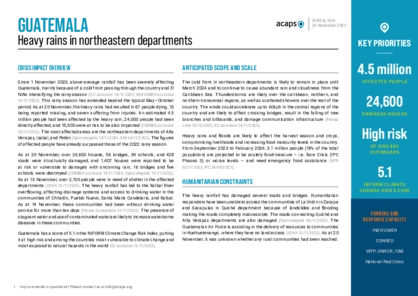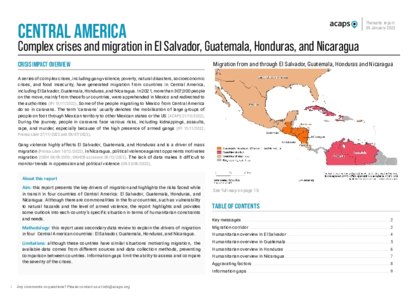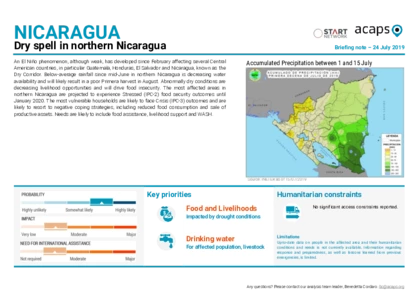Latest updates on country situation
15 September 2025
Between September 2025 and January 2026, approximately 2.6 million people (15% of the analysed population) are expected to face high levels of acute food insecurity – i.e. Crisis (IPC Phase 3) or worse levels. Alta Verapaz, Quiché, and Suchitepéquez, in central Guatemala, continue to have the highest concentration of people facing IPC 3 or worse levels. Food insecurity in the country is primarily driven by climatic shocks associated with El Niño-induced dry spells and rising food prices. (IPC 11/09/2025, IPC 11/09/2025)
08 July 2024
By 9 July 2024, heavy rains during the May–October rainy season, compounded by the effects of Tropical Storm Alberto, had led to the evacuation of more than 17,000 people. The rains had also damaged over 6,000 houses, at least 39 schools, and 481 roads. The hardest-hit areas include northern Guatemala and the Pacific coastal region. Road and bridge damage constrain access to the affected areas. The most urgent needs for those affected are food, emergency healthcare, and shelters. The Government has declared a state of calamity for the entire country, which will last 30 days after its entry into effect on 8 July. (OCHA 28/06/2024, CONRED accessed 09/07/2024, La Prensa Grafica 08/07/2024)
20 December 2023
5.3 million people are projected to require humanitarian assistance in Guatemala in 2024 – an increase of 300,000 from 2023. Their key needs are access to food (particularly for children under 5 years old and IDPs), healthcare services, WASH, housing, and protection. Food insecurity spread in 2023 to new municipalities and communities outside the Dry Corridor, historically the most affected region in the country. This is partly caused by the impact of El Niño, which has compounded droughts and tropical storms. The availability of water was also reduced by heat waves and droughts in 2023. The number of people on the move in Central America increased by 200% in 2023, resulting in a heightened demand for humanitarian services in countries along the route to North America. (OCHA 20/12/2023, OCHA 02/01/2024)
15 November 2023
As at 10 November 2023, heavy rainfall and strong winds had affected more than 4.5 million people since the start of the rainy season in May. The disaster had led to the evacuation of nearly 23,600 people, killed at least 65, and damaged more than 7,700 buildings. People likely need shelter, water, and food. (PAHO 13/11/2023, ECHO 12/10/2023)
15 August 2023
Since the start of the rainy season in May 2023, heavy rainfall had affected more than 1.55 million people in the central and southern regions of the country as at 11 August. Among those affected, more than 4,500 have evacuated from their homes, and at least 8,900 are still at risk of evacuation. Nearly 25 people have died in nine departments. As at 14 August, the rains had moderately affected over 3,100 houses and severely damaged 116 others. There is limited information about current needs, but in previous flooding incidents during the rainy season, people needed water, food, and shelter. Flooding and landslides have affected agricultural activities, and food prices are likely to increase. The rains have also damaged roads and bridges, making access to certain areas difficult until repair activities are completed. (CONRED accessed 14/08/2023, FEWS NET 02/08/2023, OCHA 07/08/2023)
current crises
in
Guatemala
These crises have been identified through the INFORM Severity Index, a tool for measuring and comparing the severity of humanitarian crises globally.
GTM001 - Climatic Shocks and Violence
Last updated 27/11/2025
Drivers
Conflict/ Violence
Drought/drier conditions
Crisis level
Country
Severity level
3.3 High
Access constraints
1.0
Analysis products
on
Guatemala
13 March 2024
Guatemala: anticipated impact of drought
DOCUMENT / PDF / 401 KB
As at December 2023, El Niño-related drought had already affected 15 of Guatemala’s 22 provinces. Drought and high temperatures are projected to continue through May 2024. Effects may be particularly severe in Guatemala’s Dry Corridor.
24 November 2023
Guatemala: heavy rains in northeastern departments
DOCUMENT / PDF / 292 KB
Since 1 November 2023, above-average rainfall has been severely affecting Guatemala, mainly because of a cold front passing through the country and El Niño intensifying the rainy season. This rainy season has extended beyond the typical May–October period and has damaged several roads and bridges.
05 January 2023
Central America: Complex crises and migration
DOCUMENT / PDF / 1 MB
This report presents the key drivers of migration and highlights the risks faced while in transit in four countries of Central America: El Salvador, Guatemala, Honduras, and Nicaragua. Although there are commonalities in the four countries, the report highlights and provides some outlook into each country’s specific situation in terms of humanitarian constraints and needs.
Attached resources
24 July 2019
Nicaragua: Dry spell in the north
DOCUMENT / PDF / 502 KB
An El Niño phenomenon, although weak, has developed since February affecting several Central American countries, in particular Guatemala, Honduras, El Salvador and Nicaragua, known as the Dry Corridor. The most vulnerable households are likely to face Crisis (IPC-3) outcomes and are likely to resort to negative coping strategies, including reduced food consumption and sale of productive assets. Needs are likely to include food assistance, livelihood support and WASH.
29 October 2018
Guatemala: Migrant Caravan
DOCUMENT / PDF / 291 KB
Since 13 October, several thousand migrants have left Honduras, El Salvador and Guatemala to form two large caravans and multiple smaller groups travelling by foot towards the United States border. Protection concerns, as well as, urgent food, water and shelter needs, have been reported.






